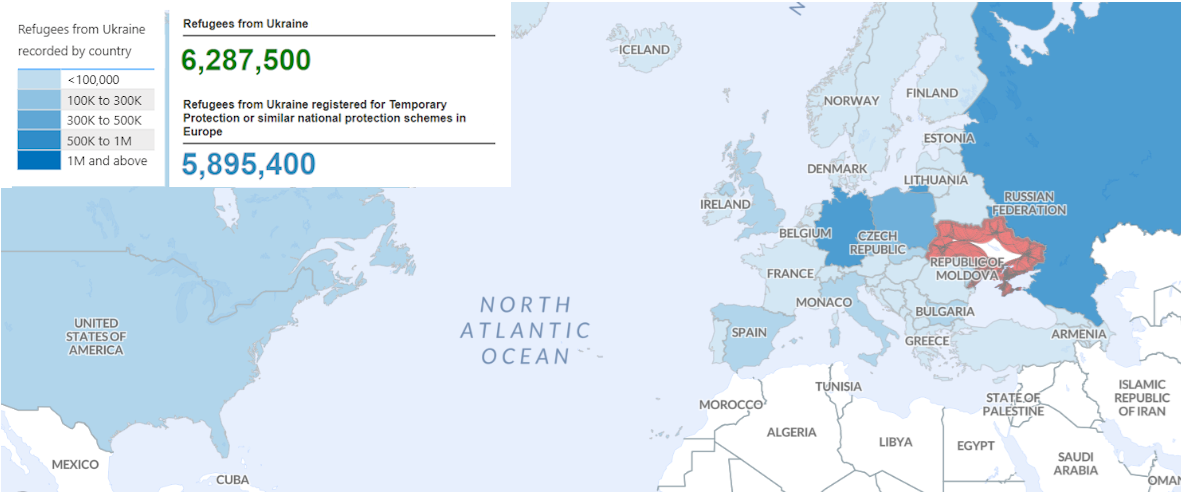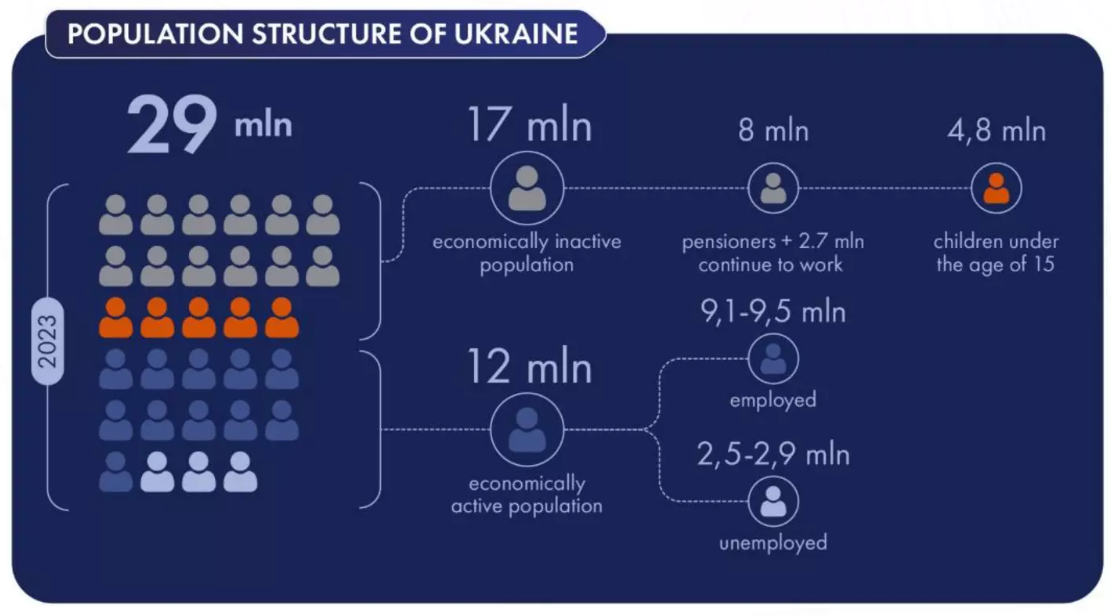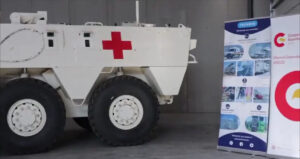Number of refugees from Ukraine in selected countries as of 01.12.2023

Source: Open4Business.com.ua and experts.news

More than 8 thousand video cameras have already been integrated into a single all-Ukrainian video surveillance platform, said the Prime Minister of Ukraine Denis Shmygal
“An important task is the protection of Ukrainians from crime. We are creating a unified video surveillance platform. Of more than 50 thousand available video cameras, more than 8 thousand have already been integrated, and this work is constantly ongoing,” Shmygal said at a government meeting on Tuesday.
Prime Minister emphasized that the authorities are changing the standards of security in civilian life, which is a wartime need that will remain after the war. “Therefore, the formation of a safe environment for our citizens will be one of the government’s priorities for this and the next years,” he said.
Population structure of Ukraine (data from ukrainian institute of future)

Source: Open4Business.com.ua and experts.news

The Ukrainian research and production enterprise ENERGO-PLUS is expanding its capabilities by becoming a co-founder of one of the oldest and most experienced electrical equipment companies in Poland.
This strategic step became possible due to the launch of joint activities with the Polish company TWERD Energo-Plus Sp. z o.o. The partnership resulted in the creation of the Ukrainian-Polish company TWERD Energo-Plus, which will allow promoting the equipment of SIC ENERGO-PLUS and Conversion Technology LLC on the European and global markets. This will create an alternative to the de facto monopoly on the global market of Chinese manufacturers of high-voltage frequency converters for 6 and 10 kV motors.
“Today, the company is investing resources in energy technologies to become one step closer to building an energy-independent economy in Ukraine. We are planning to use the latest developments from TWERD Energo-Plus Sp. z o.o., relying on their unique expertise and many years of experience in developing flagship equipment that has proven itself in the world. Thanks to our joint efforts, we will be able to offer high-voltage frequency converters for motors that drive pumping equipment and conveyors, mine hoists and other equipment at industrial and mining enterprises, water utilities, water supply systems, etc. Our own production in Ukraine will allow us to reduce the cost of this equipment and become competitive in the market, competing with Chinese and Taiwanese manufacturers, especially taking into account the full and qualified technical support provided by TWERD representatives in Ukraine,” commented Yevhen Korf, Director of RPE ENERGO-PLUS LLC.
The newly created consortium allows expanding the production base to 5000 square meters and combining the efforts of the two companies’ own electrical laboratories. In addition, this cooperation allows us to combine production facilities and a professional certified team that can provide installation and service faster than competitors in Ukraine, Poland and other countries.
Cooperation with the Polish company is already helping the Ukrainian company to manufacture and service frequency converters for medium and high voltage with the effect of recovery, inverters for alternative energy sources and storage devices, charging stations for electric vehicles.

Reference:
RPE ENERGO-PLUS LLC is one of Ukraine’s leading enterprises in the energy sector. Its core business is the design, development, and implementation of industrial automation, power supply, and various electrical systems for Ukrainian enterprises and private companies.
The international group of companies combines the efforts of the Polish manufacturer TWERD Energo-Plus Sp. z o.o. and the Ukrainian consortium ENERGO-PLUS, which includes SPE ENERGO-PLUS LLC, NV LLC Conversion Technology and LLC High Voltage Technologies Group.
Official websites of the companies: https://energo-plus.com.ua/ and https://twerd.pl/uk/

Spain will donate two medical armored vehicles to Ukraine to provide medical assistance and evacuate patients, the Spanish Agency for International Development Cooperation (AECID) reports.
“Spain’s humanitarian aid to Ukraine over the past two years has exceeded 466 million euros, the largest emergency response for a single country,” AECID said in a statement.
Spanish Foreign Minister José Manuel Albares inspected the armored ambulances that will be transferred to Ukraine.
“Spain will continue to support Ukraine in its defense of peace and freedom for as long as it takes,” the foreign minister wrote in a statement.

In 2023, registrations of new and used electric vehicles in Ukraine increased 2.8 times compared to 2022 – up to 37.6 thousand, in particular, the share of new ones increased to almost 20% from 17%, Ukravtoprom reported on its Telegram channel.
According to the association, out of the total number of registered electric cars, passenger cars accounted for more than 36.8 thousand, and commercial cars – 770.
Volkswagen ID.4 (2,655 thousand units) became the leader in the market of new battery-electric vehicles (BEVs), Dong Feng / Honda M-NV (559 units) took the second place with a large gap from the leader, and Volkswagen ID.6 was third – 491 units.
Honda eNS1 took the fourth position (327 units), and BYD Song rounded out the top five with 189 units registered.
In the used segment, the Nissan Leaf is confidently leading with 5.19 thousand units, followed by the Tesla Model 3 – 3.282 thousand units; Volkswagen e-Golf – 3.273 thousand units; Tesla Model Y – 2.171 thousand units and Volkswagen ID.4 – 1.74 thousand units.
“Ukravtoprom notes that in December last year, more than 4.6 thousand electric cars were added to the Ukrainian fleet, almost three times more than a year earlier, including more than 4.5 thousand cars and 78 commercial vehicles.
As reported, in 2022, according to Ukravtoprom, the electric vehicle market grew 1.5 times by 2021, to 13.6 thousand units, while the share of new cars increased to 17% compared to 14%, and the most popular car was also the used Nissan Leaf with 2,349 thousand units registered.